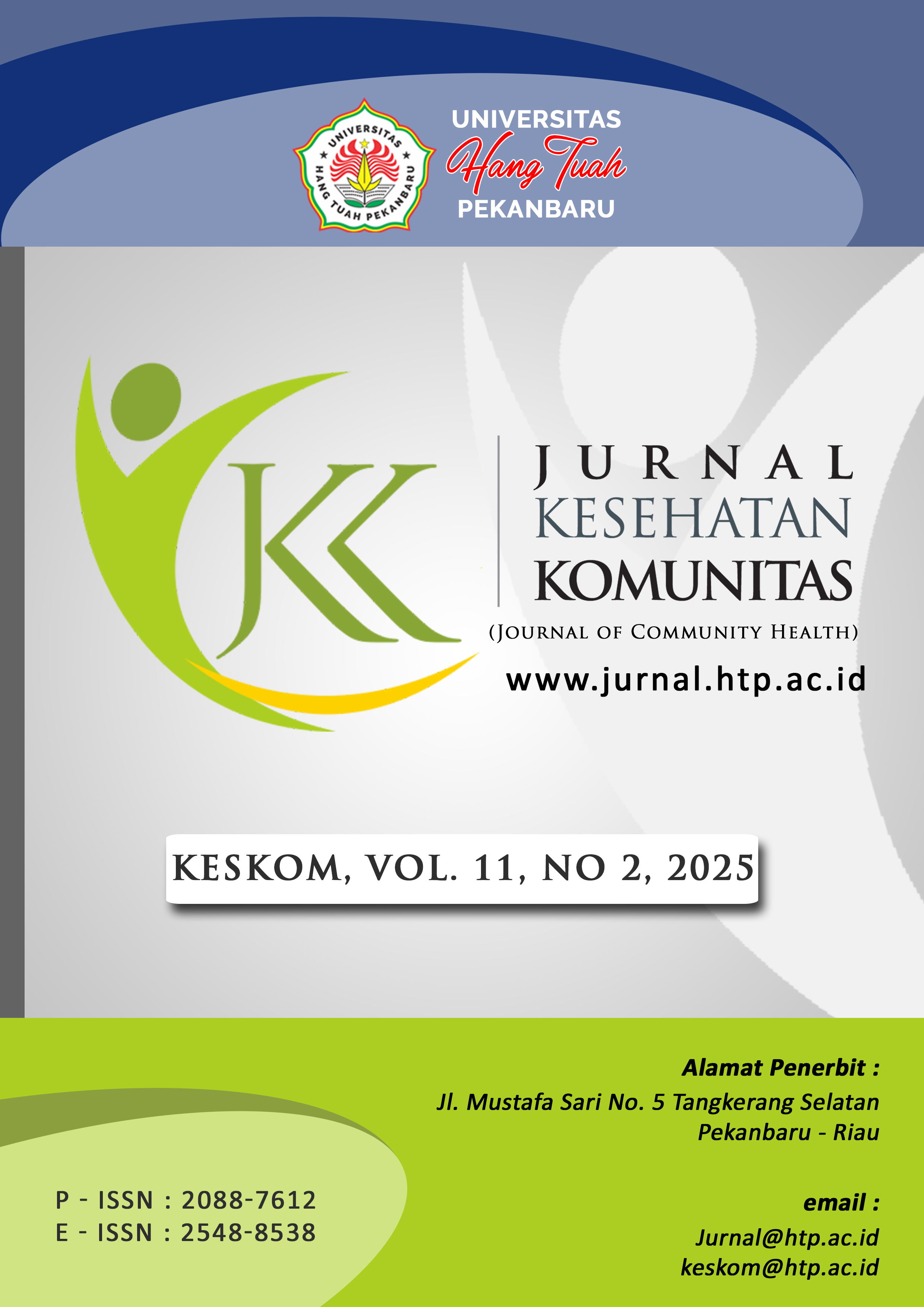Determinants of CERDIK Behavior as an Effort to Prevent Non-Communicable Diseases in students of Hang Tuah University Pekanbaru
DOI:
https://doi.org/10.25311/keskom.Vol11.Iss2.2172Keywords:
CERDIK Behavior, Knowledge, Attitude, Resources, Social SupportAbstract
CERDIK behavior is the behavior of preventing non-communicable diseases. According to the initial data survey of students who have non-communicable diseases at Hang Tuah University, Pekanbaru, as many as 17 students, including hypertension, diabetes mellitus, and asthma. The purpose of this study was to determine the factors associated with CERDIK behavior with knowledge, attitudes, sources of information, social support (family and peers) in Hang Tuah University students in Pekanbaru. This research method is quantitative analytic with cross sectional research design with proportional random sampling technique. The population of this study was 2434 students. The sample of this research is 182 students. Measuring tool used is a questionnaire. Processing data using computerization. The analysis used was univariate and bivariate analysis with the chi square test. The results of this study show that the factors associated with CERDIK behavior have a P value <α 0.05, namely knowledge (p = 0.002, POR = 2.852), attitude (p = 0.000, POR = 16.060), sources of information (p = 0.017, POR = 2.603), and social support (family and peers) (p = 0.000, POR = 5.677). From these results it can be concluded that all of the four variables are related to CERDIK behavior (knowledge, attitudes, sources of information, and social support (family and peers) in Hang Tuah University students in Pekanbaru. The suggestion in this study is that students apply CERDIK behavior to prevent non-communicable diseases and to Hang Tuah University Pekanbaru to make early prevention programs for students to avoid non-communicable diseases.
Downloads
References
1. Ambarwati, P. D., Pinilih, S. S., & Astuti, R. T. (2019). Gambaran Tingkat Stres Mahasiswa. Jurnal Keperawatan Jiwa, 5(1), 40. https://doi.org/10.26714/jkj.5.1.2017.40-47 DOI: https://doi.org/10.26714/jkj.5.1.2017.40-47
2. Andriana Y. (2017). Determinan Perilaku "CERDIK" sebagai upaya pencegahan penyakit tidak menular pada masyarakat peserta posbindu PTM. In Repository. Unej. Ac.Id.
3. Bustan, M. N. (2015). Manajemen Pengendalian Penyakit Tidak Menular. Rineka Cipta, 2012.
4. Damasceno, A. (2016). Noncommunicable Disease. In Heart of Africa: Clinical Profile of an Evolving Burden of Heart Disease in Africa. https://doi.org/10.1002/9781119097136.part5 DOI: https://doi.org/10.1002/9781119097136.part5
5. Eagle, D. E., Hybels, C. F., & Bell, R. (2018). Perceived Social Support, Received Social Support, and Depression among Clergy. Journal of Social and Personal Relationships, 20 (10), 1-19.
6. Falabiba, N. E. (2019). Landasan Teori Sikap dan Perilaku. 8–18.
7. Habut, M. Y., Nurmawan, I. P. S., & Wiryanthini, I. A. D. (2015). Hubungan Indeks Massa Tubuh dan Aktivitas Fisik terhadap Daya Tahan Kardiovaskular pada Mahasiswa Fakultas Kedokteran Universitas Udayana. Erepo Unud, 831, 1–14.
8. Hariawan, H. (2020). CERDIK Meningkatkan Pengendalian Penyakit Tidak Menular di Indonesia. : : Tunas-Tunas Riset Kesehatan, 10(1), 16–20.
9. Irwan. (2017). Etika dan Perilaku Kesehatan. Absolute Media.
10. Junaidi et al., (2023) Junaidi, A., Rahayu, D., Arisandi, W., Adyas, A., & Karyus, A. (2023). Hubungan Tingkat Pengetahuan dan Sikap dengan Perilaku Cerdik Hipertensi Pada Remaja. 11(April). DOI: https://doi.org/10.47218/jkpbl.v11i1.200
11. Kemenkes. (2016). Cek Kesehatan secara Rutin.
12.
13. Kemenkes RI. (2018). Hasil Riset Kesehatan Dasar Tahun 2018. Kementrian Kesehatan RI, 53(9), 1689–1699.
14. KemenKes RI. (2018). Rencana Aksi Nasional Penyakit Tidak Menular 2015-2019. In Kementrian Kesehatan RI (pp. 1–166).
15. Masriadi. (2019). Epidemiologi Penyakit Tidak Menular (T. Ismail (ed.); 2nd ed.). Trans Info Media.
16. Natoatmodjo, S. (2018). Promosi Kesehatan Teori & Aplikasi. Rieneka Cipta
17. Ofori, D. A., Anjarwalla, P., Mwaura, L., Jamnadass, R., Stevenson, P. C., Smith, P., Koch, W., Kukula-Koch, W., Marzec, Z., Kasperek, E., Wyszogrodzka-Koma, L., Szwerc, W., Asakawa, Y., Moradi, S., Barati, A., Khayyat, S. A., Roselin, L. S., Jaafar, F. M., Osman, C. P., … Slaton, N. (2020). Hubungan Pola Asuh Ibu dengan Regulasi Diri Remaja Akhir. Molecules, 2(1), 1–12.
18. Permenkes, 2015. (2015). Permenkes RI Nomor 71 tahun 2015 Tentang Penanggulangan Penyakit Tidak Menular. Menteri Kesehatan Republik Indonesia Peraturan Menteri Kesehatan Republik Indonesia, Nomor 15(879), 2004–2006.
19. Purnama, R. (2021). Model perilaku pencarian informasi (analisis teori perilaku pencarian informasi menurut David Ellis). Pustaka Karya : Jurnal Ilmiah Ilmu Perpustakaan Dan Informasi, 9(1), 10. https://doi.org/10.18592/pk.v9i1.5158 DOI: https://doi.org/10.18592/pk.v9i1.5158
20. Pusphandani, C. T. & M. E. (2015). Pengantar Dasar Ilmu Kesehatan Masyarakat.
21. Rahayu. (2021). Profil Kesehatan Provinsi Riau. Journal of Chemical Information and Modeling, 9, 1–287.
22. Rif’ati, R. etMas I., VDMA, M. I., Fähling, J., Industry, M., Nielsch, W., Abbildung, D., Turtle, P., Lanza, G. et al., Messe, H., Cases, U., Ar-anwendungen, P., Reality, A., Werkzeug, M., App, D., Vsm, S. I. M., E.V., T.-I. S. K., BSI, B. F. S. in der I., Group, S. S., Heller, J., … Komission, E. (2018). , Azizah Arumsari, Nurul Fajriani, Virgin S Maghfiroh, Ahmad Fathan Abidi, Achmad Chusairi, Cholichul Hadi. Bitkom Research, 63(2), 1–3.
23. Rusiana, H. putri. (2021). Pendidikan Teman sebaya Solusi Problematika Pendidikan dan Kesehatan.
24. Salim, I. H., Sibarani, J. P., Pryta, A., & Simaremare, R. (2023). Pengaruh Dukungan Sosial terhadap Perilaku CERDIK Mahasiswa Kedokteran Universitas HKBP Nommensen Medan The Effect of Social Support on CERDIK Behavior among Medical Students at HKBP Nommensen University Medan. 29(1), 11–17. DOI: https://doi.org/10.36452/jkdoktmeditek.v29i1.2444
25. Sari, L. M., & Ardianto, A. J. (2021). Hubungan Tingkat Pengetahuan Terhadap Perilaku “CERDIK” pada Penderita Hipertensi Selama Masa Pandemi Covid-19 di Wilayah Kerja Puskesmas Gulai Bancah Bukti Tinggi. Jurnal Kesehatan Tambusai, 2, 368–374. DOI: https://doi.org/10.31004/jkt.v2i4.3236
26. Sasmita, R. S. (2020). Research & Learning in Primary Education Pemanfaatan Internet Sebagai Sumber Belajar. Jurnal Pendidikan Dan Konseling, 1, 1–5. DOI: https://doi.org/10.31004/jpdk.v1i2.603
27. Sekarrini, R. (2022). Gambaran Faktor Risiko Penyakit Tidak Menular Di Kelurahan Umban Sari Kecamatan Rumbai Pekanbaru Menggunakan Pendekatan Stepwise Who. Jurnal Ilmiah Multi Disiplin Indonesia, 2(1), 163–173.
28. Soewondo, P., Johar, M., Pujisubekti, R., Halimah, H., & Irawati, D. O. (2019). Inspecting Primary Healthcare Centers in Remote Areas: Facilities, Activities, and Finances. Jurnal Administrasi Kesehatan Indonesia, 7(1), 89. https://doi.org/10.20473/jaki.v7i1.2019.89-98 DOI: https://doi.org/10.20473/jaki.v7i1.2019.89-98
29. Sudayasa, I. P., Rahman, M. F., Eso, A., Jamaluddin, J., Parawansah, P., Alifariki, L. O., Arimaswati, A., & Kholidha, A. N. (2020). Deteksi Dini Faktor Risiko Penyakit Tidak Menular Pada Masyarakat Desa Andepali Kecamatan Sampara Kabupaten Konawe. Journal of Community Engagement in Health, 3(1), 60–66. https://doi.org/10.30994/jceh.v3i1.37 DOI: https://doi.org/10.30994/jceh.v3i1.37
30. Sugiyono, P. D. (2016). Metode Penelitian Kuantitatif, Kualitatif, dan R&D. Alfabeta CV.
31. Taufik. (2021). Hipotesis Penelitian Kuantitatif. Jurnal Ilmu Administrasi, 3(2), 96–102. DOI: https://doi.org/10.33592/perspektif.v3i2.1540
32. Tarigan, M. (2018). Hubungan Dukungan Sosial Dengan Subjective Well-Being Pada Remaja Yang Memiliki OrangTua Tunggal. Jurnal Diversita. ISSN- 2461-1263. Penulisnya. DOI: https://doi.org/10.31289/diversita.v4i1.1565
33. Utami, N. M. S. N., & Widiasavitri, P. N. (2018). Hubungan Antara Dukungan Sosial Keluarga dengan Penerimaan Diri Individu yang Mengalami Asma. Jurnal Psikologi Udayana, 1(1), 12–21. https://doi.org/10.24843/jpu.2013.v01.i01.p02 DOI: https://doi.org/10.24843/JPU.2013.v01.i01.p02
34. Who. 2018. Survailance Of Noncommunicable Diseases. Switzerland : WHO press
35. Widayanti, A. (2019). Perilaku Kesehatan (Health Behavior):Aplikasi Teori Perilaku Untuk Promosi Kesehatan.
36. Yarmaliza, Z. (2019). Keywords: PTM, GERMAS, counseling ABSTRAK. 3(2), 93–100. DOI: https://doi.org/10.36341/jpm.v2i3.794
37. Yuningrum, H., Trisnowati, H., & Rosdewi, N. N. (2021). 343-916-1-Pb. 6(1), 41–49. DOI: https://doi.org/10.35842/formil.v6i1.343
Downloads
Submitted
Accepted
Published
How to Cite
Issue
Section
License
Copyright (c) 2025 Jurnal kesehatan komunitas (Journal of community health)

This work is licensed under a Creative Commons Attribution-NonCommercial-ShareAlike 4.0 International License.
Copyright @2017. This is an open-access article distributed under the terms of the Creative Commons Attribution-NonCommercial-ShareAlike 4.0 International License (http://creativecommons.org/licenses/by-nc-sa/4.0/) which permits unrestricted non-commercial used, distribution and reproduction in any medium












































